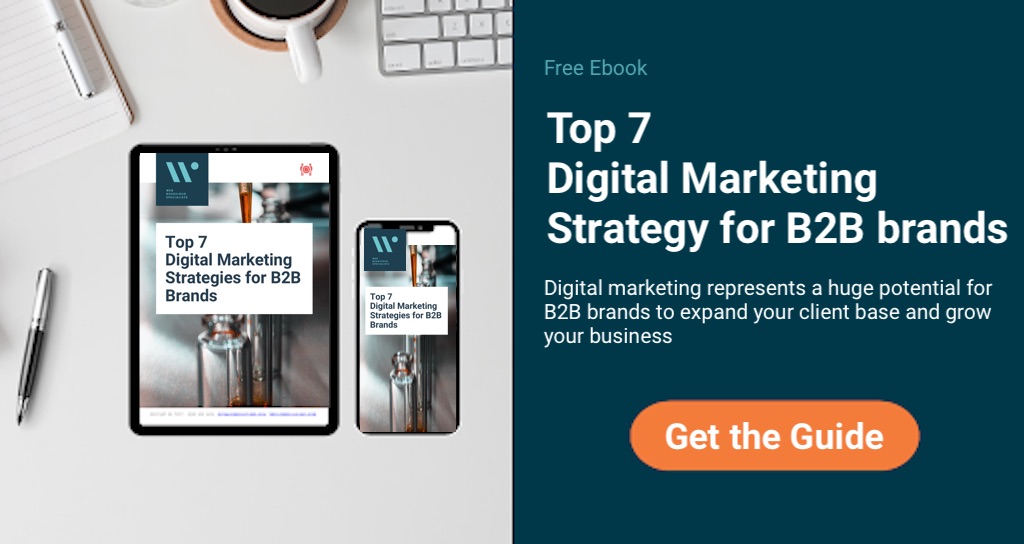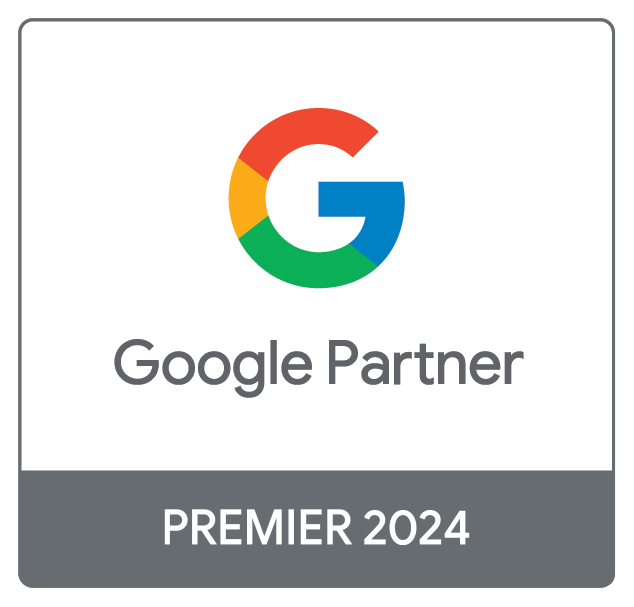B2B marketing has changed dramatically over the last few years and in order to succeed, B2B brands must go digital. Not only has the B2B buyer changed but the Business to Business buying process has changed significantly too. When researching new products and services today’s B2B buyer makes an average of 12 searches online before reaching out to a potential supplier. They now expect to find the same level of digital experience as they’d encounter during a B2C sales cycle. They’re no longer waiting to be found but are actively looking, searching for solutions to their pain points. That is why digital marketing strategies exist.
B2B Marketing Trends
It’s now less clearly defined who a B2B buyer actually is – the B2B marketing funnel has gotten longer and there are usually more people involved in the decision-making process.
Traditionally in B2B sales, there was one main buyer. They followed a predictable, controlled path through the traditional marketing funnel.
These days, it’s no longer about the sales reps going to trade shows, making cold calls or conducting business face-to-face. The modern B2B buyer does their own research, mainly online, and they make 8 to 12 online searches before they even contact the brand. And when they do, they’ve gathered enough info and are much closer to a buying decision. The new B2B buyer behaves like a B2C consumer, and they expect the same purchase experience and level of service. Nowadays, 80 percent of B2B buying decisions are based on a buyer’s direct or indirect customer experience and only 20 percent are based on the price or the actual offering.
Furthermore, more people are involved in B2B purchasing decisions. While managers and directors still have the final say and sign-off decision, there are many other parties involved in the decision-making process.
What this means is you need to create a journey-based digital experience that guides your target audience through the stages of the buyer’s journey and keeps them as raving fans and lifelong customers.
To achieve that you need to provide an online experience that not only captures the attention of all those involved in the B2B buying process but also nudges them along the sales funnel and converts them into sales.
Most B2B buyers perform 8-12 online searches before interacting with a vendor’s website and they’re already 57% of the way through the buying process before they speak with a sales representative.
Digital has changed the way B2B companies buy and the way vendors market their services. With such a high percentage of people conducting online research prior to any interaction with a brand, B2B brands have to focus on their online presence and the digital marketing channels that’ll deliver the best results from their overall marketing strategy.
So, where do you start?
51% of businesses don’t have a strategy. Do you?
The very first step into digital marketing or any form of marketing should be to develop an actual strategy. Having a marketing plan is key as it will help you remain focused, giving you a competitive advantage.
We live in an ever-evolving and increasingly digital world. If you want to be successful in B2B marketing, you have to adjust to trends and the needs of businesses in the digital age. Nowadays, your prospect not only needs to understand your solution but must trust that you have previously and you will again deliver it effectively, all while giving them the feeling that they like you and will enjoy working with you.
Having a well-designed digital marketing strategy is key for improving the effectiveness of your B2B digital marketing efforts. Every strategy should consist of clearly defined target audiences, set goals, budgets and channel strategies as well as a digital marketing plan for the coming months. Don’t forget that each plan has to be evaluated regularly and amended, if necessary, to reflect the results and meet your business and marketing goals.
There are elements of a digital marketing strategy that every company should incorporate into their digital marketing plans, so let’s look at the most important ones.
B2B Digital Marketing Strategies
1. Know your audience
First and foremost, you need to do your research and find your target audience. It’s impossible to market to everyone so you need to concentrate on your core audience. The beauty of digital marketing is the ways you can target your audience based on i.e. the information they are looking for, their interest, demographics, job titles, etc. The ability to define target audiences with great precision means you can run marketing campaigns that are far more much more relevant and, therefore, much more effective.
 Different people are motivated and engaged by different things so it’s not enough to know the job titles or company industry your potential customers are working in. You’ll have more success when you know their general demographics, their common interests, how they behave, what motivates them to purchase, how they react to certain marketing content, what their pain points are, their preferred method of communication (do they use email more than social media? Do they watch more videos on YouTube or Facebook? Are they more likely to read an infographic or a white paper?), etc.
Different people are motivated and engaged by different things so it’s not enough to know the job titles or company industry your potential customers are working in. You’ll have more success when you know their general demographics, their common interests, how they behave, what motivates them to purchase, how they react to certain marketing content, what their pain points are, their preferred method of communication (do they use email more than social media? Do they watch more videos on YouTube or Facebook? Are they more likely to read an infographic or a white paper?), etc.
By researching this information and setting up buyer personas (keeping in mind that a modern B2B sales funnel involves more than one person) you can respond with targeted messaging and content that is personalised to your customer’s specific needs. This will save you time, effort and budget which may have otherwise been spent on an irrelevant/random audience.
As a B2B company, you’ll need to have a strong sense of who and how your products/services will help your potential buyers. Researching and marketing towards your target audience will have a much greater impact when connecting with potential clients.
2. Engaging and informative website
A website is not a revelation by any means. Websites for businesses are a given. They act as an online presentation of your business to truly showcase your expertise, quality and solutions.
80% of consumers visit websites when looking for B2B companies and their products/ services.
Your B2B website is most likely the first way potential new clients will interact with your business. In the B2B space, unlike in B2C, customers are not going to make decisions based on emotions. Instead, they will decide to engage with your company only after careful consideration using all available resources.
 Your website needs to cater to the discovery mindset that your audience approaches this research with. Your website content should present a clear picture of what your organisation stands for, the services it provides, key differentiators, as well as testimonials and case studies for credibility. You have to make sure it’s showcasing your expertise while providing solutions to potential clients. Ideally, your company website should be an industry resource that engages clients and provides them with an informative and entertaining experience. While allowing them to get the info they need easily, it should also provide you with a tool that collects data including sales leads.
Your website needs to cater to the discovery mindset that your audience approaches this research with. Your website content should present a clear picture of what your organisation stands for, the services it provides, key differentiators, as well as testimonials and case studies for credibility. You have to make sure it’s showcasing your expertise while providing solutions to potential clients. Ideally, your company website should be an industry resource that engages clients and provides them with an informative and entertaining experience. While allowing them to get the info they need easily, it should also provide you with a tool that collects data including sales leads.
46% of B2B buyers will leave a website if it’s not immediately clear what the company does, and 37% will leave because of poor navigation or design.
So, what you share and how you share is crucial. On top of being stocked with great content, your website needs to be five things if you want it to generate B2B leads and sales:
- Fast– 40% of users will abandon a website if it takes longer than 3 seconds to load
- Secure – 85% of consumers won’t browse an unsecured site
- Mobile friendly – over 60% of online B2B traffic comes from mobile devices and 80% of B2B buyers use a mobile device at work to look for information, so it’s crucial for websites to be optimised for different devices.
- Actionable – 44% of B2B marketers say the main reason they abandon websites is that there is no contact info immediately visible. Your website needs clear calls-to-action like contact us, request demo, download whitepaper, etc.
- Professionally designed – 37% of B2B buyers will leave a site because of poor design or navigation
Don’t forget that changing trends and how your audience interacts with websites means that you have to stay on top of it by reviewing and auditing it regularly.
B2B research tends to be a long process with little emotion involved. Your website will make the discovery process easier by outlining how you can resolve pain points for your target audience better than the competition.
3. Content Marketing
Content is a big part of B2B marketing and 91%. B2B markets are already using this tactic to increase awareness of their brand, products, services, bringing traffic to the site and generating leads. Content marketing includes blogs, social media videos, press releases, news articles, FAQs, email newsletters, e-books, whitepapers, case studies, infographics, etc.
Why content is so important for B2B brands?
75% of B2B buyers say that content significantly impacts their buying decision and 62% say they can make a purchase selection based solely on digital content.
Over 80% of B2B buyers view at least 5 pieces of content during the purchase process, and half of them view more than 8 pieces.
Content marketing requires methodical planning and a clearly defined strategy to be successful and grow the business. There are a few important elements to consider when creating content for B2B brands.
Identify your target audience
As mentioned earlier, you need to learn about your audience and the same applies to your content efforts. You need to realise and understand the content needs and expectations of your target audience in order to design an effective strategy. Remember that you shouldn’t target only CEO’s, etc. but all people in charge of making purchasing decisions.
Set clear goals
Like all forms of marketing activity, you need to set precise and clear goals for your content marketing efforts as well as individual content pieces
Research content ideas
With a specific audience and goals in mind, you can focus on finding content ideas for your B2B content marketing campaign. You need to remember that different types of content work differently at each stage of the customer journey, e.g. blogs work great during the initial research phase whereas case studies and testimonials work better during the consideration phase. When creating content, always aim to attract the right prospects at the right stage of their customer journey. Building a knowledge resource through blogs, staying connected through email marketing and publishing informative content in the form of videos or e-books are some of the tried-and-tested content marketing strategies for B2B.
One note about blogs – Blogs in the research phase of the customer journey should make buyers aware of and interested in your product. You should identify the problems your products/services solve and incorporate them into engaging blog posts. The idea here is to move away from producing content that focuses on what you do and create more content that shows customers you understand their pain points and are capable of eliminating them.
Create content that converts
B2B has longer lead times than B2C, often extending for several months or longer. Throughout this cycle, lead nurturing through targeted content marketing can be one of the most powerful ways to push leads down the conversion funnel. Having a strong content strategy can be a powerful way of building a strong relationship with your target audience.
85% of B2B marketers say lead generation is the most important content marketing goal.
Lead magnets like e-books, free trials, webinars, content upgrades, etc. offer prospects incentives to engage with your company. It also helps to have a compelling landing page that pushes and promotes these offerings.
Don’t forget:
- you need a content distribution plan in order for your content to work for you
- The biggest mistake you can make in content marketing at any stage of the journey is to make it all about you
4. Video content
More and more B2B brands are using video to achieve various objectives: from building brand awareness, to product and service promotion, boosting conversions and lead generation. Video allows brands to engage with their target audience, build interest in their products/services within their target audience as well as building trust.
70% of B2B buyers and researchers watch videos on their path to purchase to help them make their buying decisions.
Video is a great medium to use at every stage of the sales cycle – whether its short videos shared across social platforms, interactive videos that increase conversions or case studies that emphasise the credibility of your business. The key is to share informative videos that resonate with your target audience. The right video can get executives, managers, and salespeople excited about your business and convert more leads into paying customers.
64% of marketers have attributed increased sales as a direct result of the video.
Companies that use video marketing see a 34% higher web conversion rate than those that don’t.
 If you’re targeting businesses with your video content, it’s important to remember what they want to see in it and how they’re going to engage with it. B2B brands are seeing success with LinkedIn video campaigns, how-to videos, searchable video content, user-generated content and live video events. And as there are so many social media channels that support video. Marketers can easily amplify the impact of their video content by sharing it with their online audiences…securing a nice increase in engagement and site traffic in the process.
If you’re targeting businesses with your video content, it’s important to remember what they want to see in it and how they’re going to engage with it. B2B brands are seeing success with LinkedIn video campaigns, how-to videos, searchable video content, user-generated content and live video events. And as there are so many social media channels that support video. Marketers can easily amplify the impact of their video content by sharing it with their online audiences…securing a nice increase in engagement and site traffic in the process.
Video content is a powerful tool to educate your audience and tell engaging stories. It’s also everywhere and comes in many forms. It’s the perfect time for B2B brands to take advantage of this format.
5. Search marketing
As mentioned earlier, the modern B2B buyer does their own research, mainly online and they make 8 to 12 online searches before they even contact the brand.
With the already narrow market B2B companies operate within, it’s crucial that consumers looking for services find companies that are able to provide them with the right solution. Search marketing, both SEO and PPC, can bridge this gap and help B2B brands gain visibility. After all, even the best website is of no use unless your audience is able to find it easily.
30% of B2B marketers spend no time on SEO each week while 55% spend no time on PPC.
Don’t miss out on the potential of search marketing for B2B. Both can drive traffic to the site at the top of the funnel as well as drive conversions at the bottom of the funnel in a cost-effective manner.
SEO (Search Engine Optimisation)
71% of B2B researchers begin their research with generic Google searches and do an average of 8-12 searches prior to engaging on a specific brand’s site.
Search engines have become the primary method of research for business buyers at all stages of the decision-making process. From the time they start identifying a problem right through to selecting a company to buy from. Being discoverable in search is therefore essential. Let’s take a look into a few elements that describe B2B SEO.
B2B SEO needs to reach multiple decision makers
Because B2B purchases tend to be significant, long-term investments, more people need to be involved in the buying decision. Practitioners, managers, and executives will each approach the decision and their research with very different problems in mind. So you can expect them to be searching Google with very different queries. It’s therefore important to make sure your website content answers different types of questions and is optimised towards them.
B2B SEO relies on low-volume keywords
The B2B space is smaller than B2C and that means your SEO strategy needs to account for high-value but low-volume keywords.
Keyword research is the core of a successful SEO strategy regardless of whether you’re just getting started with a new website, redesigning an existing one or just looking to update your content.
It’s important to note that you shouldn’t exclusively focus on individual keywords when creating or optimising content, but focus on topic clusters. On top of understanding how different terms are connected, you also need to focus on the intent behind each search and address it with the content you create.
High-quality content is one of the most important factors for the success of your SEO strategy. SEO can support you in different stages of the customer journey, from research to lead generation and conversion. When you invest time to learn about your potential customers’ needs and give them something that can help them overcome their challenges, they will reward you with their loyalty. So:
- Take time to learn about your audience
- Create content that answers their questions
- Give them more value in the form of downloadable documents. Here you can request their contact details and turn them into leads
B2B SEO does not turn your visitors directly into leads
 The B2B space has a much longer sales cycle and more stakeholders than B2C.
The B2B space has a much longer sales cycle and more stakeholders than B2C.
That means your B2B SEO content shouldn’t be built (nor expected) to convert cold organic visitors into sales. There may be some high–purchase intent searches in your industry that are the exception to this rule. For the most part, people Googling in the B2B space aren’t ready to buy anything yet. They’re looking for the tools and information they need to do their jobs. So, while SEO is great to bring relevant traffic to your site and make people aware of your brand, products or services, you need some lead nurturing techniques to actually convert them into customers.
B2B SEO emphasises thought leadership and branding
Because B2B searchers aren’t likely to convert on their first visit. B2B SEO tends to be more about establishing the brand in the searcher’s memory as opposed to getting them to make a purchase.
That means B2B SEO isn’t just about making sure your website shows up when people search for your product category. It’s about getting your audience used to seeing your website when they Google questions related to their questions or problems.
A good B2B SEO strategy builds trust in your market. It shows the people you’re trying to reach that they can count on you to help them solve their problems.
Paid campaigns (PPC)
As I pointed out earlier, search engines have become the primary method of research for business buyers at all stages of the decision-making process. Being discoverable in search is therefore essential. As SEO might be a slow process. You might not be getting the desired results as quickly as you’d like. If your budget allows, consider including PPC campaigns in your digital marketing efforts.
54% of B2B companies confirmed that paid search campaigns generate leads and a positive ROI for their business.
Done right, paid search is one of the most effective ways to market your B2B business. It allows you to get in front of your audience at the exact moment that they’re looking for your solution.
PPC ads are a great opportunity to gain attention from interested users who may have never found your products/services otherwise. It’s a great tactic to get in front of your target audience at every stage of their journey. For building brand awareness, generating leads and driving conversions.
6. Social media
Social media is here to stay and as a B2B business owner. It needs to be a part of your B2B digital marketing strategy. Why?
75% of B2B buyers use social media to support their purchase decision. Making it a more commonly used source of information than formal referrals and recommendations.
While there is no doubt that social media is a powerful marketing tool, it has to be done effectively to achieve a high return on investment. For social media marketing to be successful, a B2B company needs to take a strategic approach and execute their campaigns with precision.
As with all marketing activities, there are some essential steps to planning your strategy well and getting the desired results:
- Define your social media objectives – your return on investment depends on setting marketing goals that contribute to your company’s overall growth. Whether that’s increasing brand awareness, lead generation or customer retention. you need to define your objectives and set goals for the coming months.
- Identify your target audience – Social media is made up of diverse people. So not everybody is going to be interested in the content you share. Which is why it’s important to reach out to an audience that connects to you and your content. You want businesses who pay attention and listen to your advice. Being in the B2B segment, this not only helps you build a list of followers, but also lets you create real authority and a positive brand in your niche.
- Choose the right social media platforms – Every social media network is different and serves different purposes. And the people that use it have different interests and priorities. So, you need to understand social media platforms and choose the best ones for your B2B business in order to grow and expand. When your B2B company experiments with social media marketing, you must appreciate the importance of selecting the right social media platform. When selecting a platform, it’s important to assess how it can be used to reach the organisation’s main objectives and build an audience.
65% of B2B marketers have obtained leads from LinkedIn, 52% from Facebook and 44% from Twitter.
B2B marketers say LinkedIn, Twitter, Facebook, Instagram and YouTube are the main platforms they use to engage with their potential customers and generate leads.
Most B2B marketers use social media platforms to distribute, promote and repurpose existing content. Good use of social media can include engaging visuals and giving helpful info such as:
- Industry and business tips
- Industry news
- Statistics and “did you know?” style info
- Pain points and solutions
- Cool features, updates to your B2B products/services
- Success stories, case studies
- Testimonials (especially video)
- instructional videos made by your company
- FAQ, etc.
B2B companies have realised the power and the potential of social platforms. When done correctly, B2B social networking platforms can boost your business by increasing your brand’s visibility. There is no better way of gaining customers’ trust and building relationships than using social platforms.
However, you need to ensure that you post the right type of content on the right platforms. You must tweak your social media strategy according to which platform you’re using or planning to use.
7. Lead nurturing
B2B sales cycles can be long. Just because your potential customers aren’t ready to purchase right now, doesn’t mean they never will be. By creating a nurturing campaign, you can continue to engage your leads, keeping you top of mind, and providing them with the content they need to move closer to becoming a customer.
Check B2B lead generation strategies
Only 27% of B2B leads are sales-ready when first generated, so lead nurturing techniques are essential. About 75% of those leads will become sales-ready within 12 to 18 months.
Lead nurturing is critical to driving sales opportunities from your website. Only 35% of B2B marketers have a lead nurturing campaigns, and of these, only 45% have an effective one. A lack of effective lead nurturing is often the cause of website leads never becoming customers. You must nurture them through the buyer’s journey. Implementing an effective lead nurturing strategy can have a huge impact on the results of your inbound marketing strategy.
Tactics to nurture leads
- Create buyer personas and understand their journey – understand what the customer needs at each phase and how best to deliver it based on their preferences
- Targeted content – nurture your buyer personas with targeted content based on their interests, goals, objectives and marketing triggers
- Multichannel approach – do not limit yourself to emails, try other channels like social media, remarketing or a direct approach
- Personalised emails – these tend to produce significantly better results than generic email blasts
- Repurpose content – recycle well-performing content into new formats or redistribute it via different channels
- Thought leadership – Provide your leads with high quality, thought through content that shows you as an authority in your niche
- Type of content – experiment with different types of content like e-books, videos, blog posts, podcasts, webinars or infographics to broaden the audience who will engage with your content
- Educate according to the buyer’s journey – one of the most crucial steps in closing the sales cycle is educating your prospects and giving them the information they need in their current stage of the buyer’s journey
- Remarketing ads – use website visitor identification data to show your ads to leads that have already interacted with your business in some way
Proper lead nurturing is the only way to turn a site visitor into a customer. As your potential customers research the web looking for answers and solutions, they’re most likely to buy from the business who delivers this content best. With lead nurturing techniques you can be the first to provide answers and forge a relationship.
Don’t forget to use prominent CTAs across the site and use landing pages to maximise your inbound campaigns.

Other strategies
Additional elements that are very important for B2B brands.
Analytics
Most marketers know that metrics are important, and they already attempt to track at least some of the available data. However, less than half of B2B marketers use web analytics and data to optimise and improve their marketing efforts.
The huge amounts of data available make measuring the success of B2B marketing efforts very tricky. There are lots of metrics that can be measured. But we need to make sure we measure the ones that have a direct impact on our business. For example, revenue, leads generated, downloaded assets, engagement with the website, etc.
Online/offline integration
Adopting a digital marketing strategy doesn’t mean disregarding traditional marketing. Both approaches have their own unique advantages and one cannot replace the other. Instead, both your offline and online marketing efforts need to be seamlessly integrated so they can support each other. The foundation of most B2B businesses is relationships. Relationships with future or current clients need to be nurtured over time for sustained revenue growth. The key to developing these relationships is backing up your digital touchpoints with offline support and vice versa.
Referral marketing
A lot of studies show that referrals are no longer coming from clients alone. But also from strangers online—just for the sheer fact that a business’ reputation was good enough.
Social proof will be a strong advocate for the success of your business and it doesn’t stop with testimonials. Content marketing is really setting yourself apart. As a reputable leader in your B2B area can really help others believe. Also, to share that you’re a top-quality business to partner with. Even if they haven’t worked with you directly. If done well, your business can stick in people’s brains and they’ll want to share it with other people. This brand recognition can lead to client referrals and new business.
Online advertising
Online advertising opens up many possibilities for marketing teams to scale, reach new contacts and nurture leads through their funnel. B2B lead generation is a major goal for marketing teams. Online advertising helps them reach wider audiences and grow their leads generated KPIs. This can be through any channel i.e. Paid Search, social media, YouTube advertising, etc. Depending on your objectives, target audience and budget, you need to identify the best channels for your brand and give it a try.
Summary
B2B businesses can no longer solely focus on outbound and direct marketing techniques, such as contacting prospects directly. Although some outbound methods do work, they alone are not the best ways to bring in new clients.
Digital marketing represents a huge potential for the B2B space to expand their client base and grow their business. With these strategies, your brand can develop a strong and credible online presence to drive greater results.
Don’t feel that you need to try them all though. Not all of these strategies are appropriate for every B2B business. Research what methods are most effective for your business needs and your sector, then implement your bespoke digital marketing strategy…
…which is obviously easier said than done! If you want our help with the design of a bespoke B2B marketing strategy for your business, get in touch. We’ll find the best solution for you.









